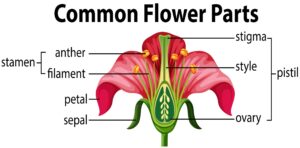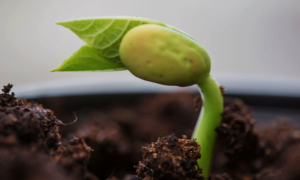Reproduction :-
Reproduction is the biological process by which new individual organisms ( offsprings ) are produced from their parents.
It is a fundamental features of all known life.
Types of Reproduction :-
There are of mainly two types. –
- Asexual Reproduction.
- Sexual Reproduction.
Asexual Reproduction :-
It is the biological process in which an organism can reproduce without the involvement of another organism.
The cloning of an organism is a form of asexual reproduction.
It occurs in unicellular and multicellular organisms.
- By asexual reproduction an organism creates a genetically similar or identical copy of itself.
- There is no gamete formation or fertilization.
Types of Asexual Reproduction :-
( a ) Sporolation.
( b ) Fission methods.
( c ) Budding methods
( d ) Fragmentation.
( e ) Vegetative propagation.
Sporolation or spores formation :-

Sporolation is a method of asexual reproduction which is found in non flowering plants such as fungi ( Rhizopus , Mucor , Penicillium ) and Bacteria.
In this method the parent plant produces hundreds of tiny spore which can grow into new plants.
- In Rhizopus numerous spores are produced whithin sacs like stucture called sporogonia.
The sporogonia are present at the top of the thread like structures called hyphae.
When these sporogonia brusts , the spores are scattered under suitable conditions and develop into new Rhizopus plant.
Types of Spores :-
( a ) Aplanospores :-
These are non motile spores. These Spores are non motile due to the absence of of flagella in them.
( b ) Zoospores :-
The motile spores are called zoospores. These spores are due to the presence of flagella in them.
Fission methods :-
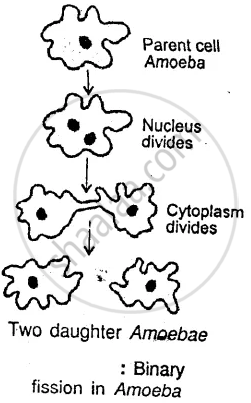
It is the division of a single entinty into two or more parts and the regeneration of those parts into separate entities resembling the original.
- Fission may be binary and Multiple Fission.
- In binary fission parent cell divides into two equal halves called daughter cells. Daughter cells are identical to each other and to their parent cell.
- Organisms like Amoeba, Bacteria, Euglena, Paramecium exhibit binary fission.
- During Multiple Fission organism divides itself into numerous daughter cells.
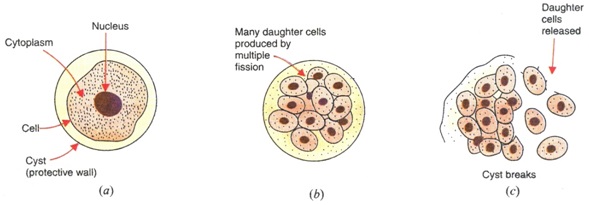
Example. – Algae and Sporozoans exhibit Multiple Fission.
Budding methods :-
Some organisms develop buds on their body. These buds develop into a new individual.
This is known as budding.
Example. – Hydra, Yeast, sponges etc exhibit budding methods of asexual reproduction.
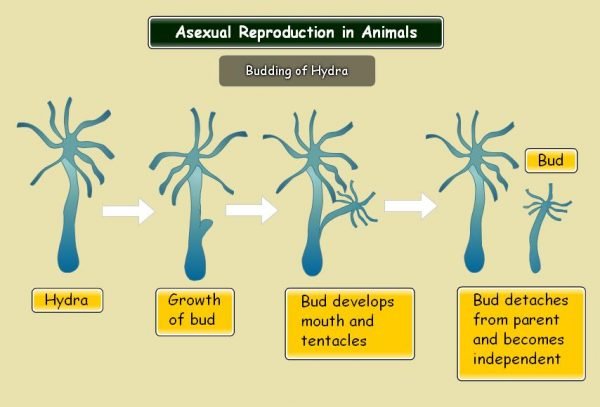
From the parent hydra a bud or arise which eventually matures into a new Hydra.
Once gets mature, it detaches from the parent body.
Yeast cell also produce many bud and it detaches from the parent cell.
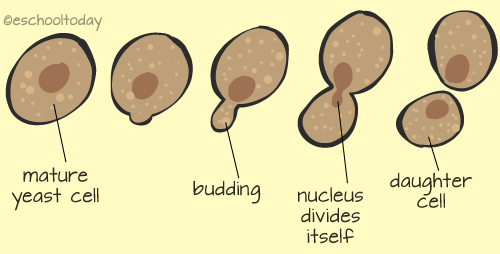
Also read :- Sexual reproduction and its stages
Also read :- Sexual reproduction in flowering plants
Fragmentation :-
In fragmentation a parent organism is split into multiple parts, each of which grows to become a complete independent offspring organism.
This process resembles budding and vegetative propagation but with some differences.

Example. – Starfish, Spirogyra some Worms,Fungi and lichens exhibit fragmentation method of asexual reproduction.
This process of asexual reproduction is also found in planaria.
Vegetative propagation :-
Vegetative propagation or reproduction is any form of asexual reproduction occuring in plants in which a new plant grows from of fragment of the parent plant.
Many plants naturally reproduce this method but it can also be introduced artificially.
Natural vegetative propagation :- New plants grow from parts of the parent plant. they includes –
Stems. – Runner are stems that grow horizontally above the ground.
They have nodes where buds are formed. These buds grow into a new plant.

Bulbs. – A bulb contains an underground stem. leaves are attached to the stem, these leaves contain much stored food. At the centre of the bulb is apical bud also attached are lateral buds.
The apical bud will produce leaves and flower while the lateral buds will produce new shoots
Example. – Onions.

Offset. – Nasturitium ( Water hyacinth ) is asexually reproduce by offset. They are lateral shoots, they develop the base of a monocots stem.
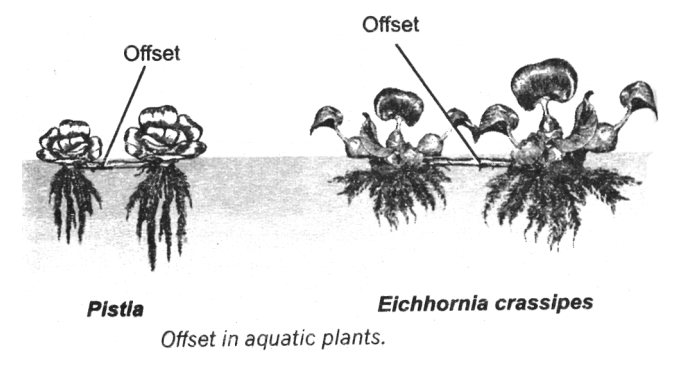
Nasturitium is a foreigner plant which is known as terror of Bengal.
Roots. – New plants will grow out of swollen modified roots called tubers ( tuberous roots ).
Buds develope at the base of the stem and then grow into new plants.
Example. – Sweet potato.

Leaves. – Leaves of some plants will grow into a new plant if they become detached from the parent plant. Other plants grow a small plants called plantlets on the edge of their leaves.
Example. – Bryophyllum.
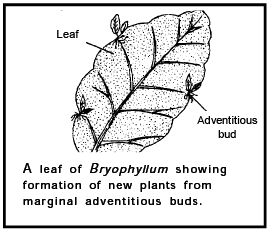
Fig. 12·17 . Vegetative propagation through Leaf in Bryophyllum.
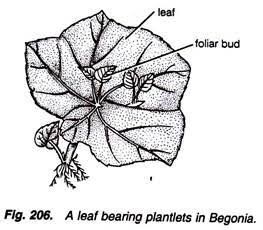
Some other Vegetative parts and their examples.
- Sucker – stem. Examples – Banana, Mint.
2. Tuber – modified stem. Example – Potato.
3. Rhizome. – modified stem. Examples.- Bamboos, Poplars, Ginger and Turmeric.
Artificial Vegetative propagation :-
1.Grafting :-

In a Grafting, two plants species are used. Part of the stem of the desirable plant is grafted onto a rooted plant called the stock, the part that is grafted or attached is called the scion.
Examples. – Roses, Citrus and Grapes.
2. Layering :-

Layering is a method in which a stem attached to the plant is bent and covered with soil.
Example. – Jasmine and Bougainvillea ( paper flower )
3. Cutting :-
Some plants are propagated through stem containing nodes and intendes is placed in moist soil and allowed to root.

Example. – Rose, Money plant, African violet and Coleus.
Advantages of Asexual Reproduction :-
- The energy requirements for reproduction are minimum.
- It can occur in various environments.
- It allows for species survival.
- Positive genetic influences are guaranteed to be passed to the next generation.
- Multiple forms of asexual reproduction are available.
- In plant asexual reproduction eliminates the need for seeds.
- Maturity is rapid.
Disadvantages of Asexual Reproduction :-
- Diversity is limited because only one parent is involved in reproduction.
- Population numbers can be difficult to control because the reproductive process is easier to complete for many Asexual organisms.
- There can be an inability to adapt. Asexual organisms are not always able to adapt to a changing environment or habit.
- Pest resistance is minimum with Asexual Reproduction.
- Asexual organisms typically have lower lifespans.
- it is an expensive process.



